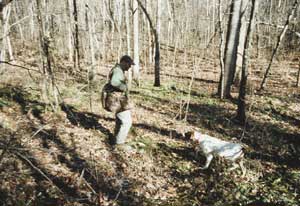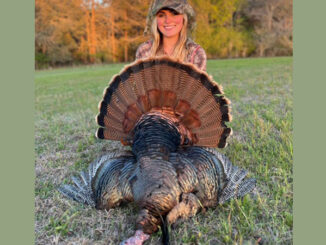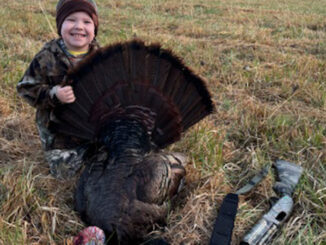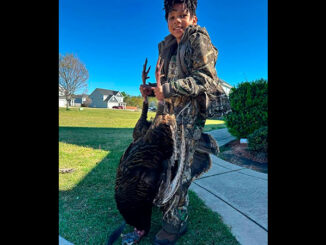
Getting turkeys separated, then calling them back, is a tradition
A trained hunting dog is a marvelous animal to observe.
Hunters and dog owners of specialty breeds — pointers, setters, beagles, Plotts, Redbones, blueticks, Walkers, Chesapeakes, Labradors, Boykins — uniformly talk about the enjoyment of “watching the dogs work” more than the actual harvesting of game.Of course, knocking down a flushed quail or rabbit in front of a dog and allowing the animal to retrieve the quarry is part of the complete package for owner and canine.
But vigorous arguments can be started by anyone who claims one breed of dog is more intelligent than another. Lab owners will vociferously promote their dogs’ smarts against Chesapeakes’, and on down the line. Of course, just as with humans, anyone who’d claim a certain brand of dog is the most intelligent ignores the fact of individual outstanding traits within separate breeds.
That being said, there must be something about the mixture of pointer and setter blood that produces turkey-hunting dogs. Even though labeled with the moniker of “turkey,” that name belies these dogs’ intelligence. And there may not be a more specialized niche of canines than “turkey” dogs.
They not only make tremendous house and guard dogs — and pets — but their real value is in finding and scattering winter flocks of turkeys and returning to their masters to await the appearance of a “lost” bird.
Jim Buckner of the Providence community in northern Caswell County has owned wild turkey hunting dogs for two-thirds of his 34 years.
“I’ve probably hunted turkeys with dogs at least 20 years,” he said.
Because he’s so close to the Virginia border, Buckner has pursued his sport in the Commonwealth state (which has had winter turkey seasons for decades) during 18 of the last 20 seasons because North Carolina prohibited winter turkey hunting after 1971. That was the year the N.C. Wildlife Resources Commission established its spring gobblers-only season.
But before then, just about nobody in Carolina hunted turkeys in the spring; it was relegated to the fall season because deer were relatively scarce across most of central and western N.C. In fact, there probably were more wild turkeys in the state during the 1950s and 1960s than deer — particularly from the piedmont’s fall line to the Tennessee-N.C. line. However, the lack of whitetails caused a problem — deer hunters had few targets except turkeys to shoot during the fall seasons. And shoot them they did — hens, jakes and gobblers.
However, hunting pressure, combined with the use of chicken manure by farmers to fertilize fields — chicken manure contains a virus called “blackhead” that’s deadly to wild turkeys — caused N.C.’s turkey population to reach a tip-over point sometime in the late 1950s and early 1960s. It then took a tremendous dive during the next 10 years. So the WRC hired a turkey expert, Wayne Bailey of West Virginia, to become its first wild turkey restoration project leader. Bailey, then later Brian Hyder and now Mike Seamster, helped bring the state’s wild turkey population back to healthy numbers, along with the National Wild Turkey Federation’s “Super Fund” that donated matching dollars to state wildlife agencies to pay for live-trapping and relocation of Eastern turkeys from one state to another. North Carolina, in fact, now has so many wild turkeys the WRC opened 10 counties three years ago to a one-week January winter hunting season.
Total winter turkey harvests haven’t been that impressive the last two Januarys —181 birds in 2004 and 151 total kills in 2005. However, that’s probably because (a) many N.C. hunters don’t know how to pursue the birds during winter; (b) they’d rather not burn one of their two yearly tags, potentially for a hen; and (c) few N.C. hunters own bona fide “turkey” dogs. After all, it’s been about 34 years since there was much incentive to breed, own or train dogs to hunt wild turkeys in North Carolina.
“My daddy (Buddy Buckner) always had turkey dogs,” Buckner said.”I think I was 10 when he got his first actual turkey dog.
“Before then, you used bird dogs that wouldn’t hold a point or would flush birds (quail) and you couldn’t break (train) to hold on point. I think they got a number of dogs from the Richmond (Va.) area. They weren’t worth anything else because they wouldn’t hold a point.”
Buckner said about 4 years ago he read an article in a magazine about a man in Lowery, Va., who had his own breed of turkey dogs.
“I called J.T. Burns,” Buckner said, “and he turned out to be the son of John Burns of Bedford, Va., the most famous turkey-dog breeder and trainer in the South.”
That call ultimately resulted in the purchase of a six-week-old female cross-bred puppy named “Lady,” who is Buckner’s main turkey dog. He also has an older dog, 7 1/2-year-old Ace, but Ace isn’t a Burns-bred hunting dog.
“J.T. won’t sell a puppy older than 6 weeks of age,” Buckner said. “He said a dog becomes imprinted on the owner, the main care-giver, after 6 weeks.”
The Burnses have bred turkey-hunting dogs for “more than 30 years,” Buckner said. “They worked on cross-breeding setters and pointers to get their own line of dogs, called ‘drop’ dogs.’
“They’ve got dogs all over the place, have sold ’em to hunters from Kansas to Pennsylvania to New York.”
The instinct to hunt wild turkeys is something that’s bred into a dog, although Buckner, as with other owners, trains his dogs from the puppy stage to be interested in turkeys, especially their scent, by using an old turkey wing attached to a string on a fishing pole.
“They hunt in big, far-ranging circles,” he said. “What Lady will do is go on a big circle around me. If she doesn’t run across a turkey’s scent, she’ll hit my backtrail and follow it to me, if she hasn’t seen or heard me. Then she’ll begin another big circle in the general direction I’m walking.
“Ace, being 8 years old, will do the same thing, but he won’t make as big a circles as Lady. I guess that’s because he’s an older dog. He’ll go out 150 to 200 yards, but she’ll be out 800 yards sometimes.”
It’s a hunting technique well-known to upland bird hunters who have dogs that range in approximately the same manner — circling fields to get the scent of a covey of birds.
Once Ace or Lady discovers the scent of a turkey or a flock of birds, they’ll begin trailing them at a run, then burst into the flock while barking, scattering them. Sometimes the birds will simply run away; sometimes they’ll take to the air.
Turkeys usually will fly from 200 to 400 yards, going in all directions. But the breakup of a flock doesn’t make finding them difficult for hunters — it makes getting a shot more likely. In fact, it’s just about the only way to hunt wild turkeys in the winter because the birds aren’t interested in breeding, so the males don’t gobble as they do each spring, and hunters can’t lure them with love-sick hen yelps, cackles or purrs.
But turkeys are sociable birds, the main reason being every predator in the woods likes to dine on them. So multiple eyes watching for a bobcat, fox, coyote — or a man — are better than two eyes. That also means when the birds are “busted up” by a natural marauder or a human, the turkeys’ instinctive reaction is to get back together.
Scattered flocks reassemble by calling to one another. Usually an old or “boss” hen will be in control of a flock of hens or yearling males (jakes) in winter. The older gobblers usually remain segregated in their own smaller flocks.
A boss hen often makes a “lost” call (usually a series of three soft yelps). Then there’s the “kee-kee run” call younger birds make after losing contact with the group — they’re saying “I’m lost and I need somebody to yelp so I can locate you.”
So the tactic of a good turkey hunter is to disperse birds, find a spot near where the scattering took place, take a seat against a tree while wearing full body and facial camouflage, and get the dog to sit down near him and remain motionless. The hunter then yelps, hoping to get a bird to answer and come within gunshot range.
When a proficient hunter or hunters scatter a flock, it’s much easier for each man with a shotgun (No. 4 or 6 loads are the chosen shotshells for most hunters) to drop a returning bird than during the spring season. In the spring, solo gobblers only normally respond to hen calls; in the winter every turkey wanting to get together will come slipping through the woods, trying to find the boss hen.
But the birds nonetheless still are wary when they return, so remaining motionless is key to success. That’s where turkey “drop” dogs display their intelligence once again.
“I’d heard about people who had dogs that would get in a ‘blind’ with them when they had a turkey coming in and that’s what I wanted,” Buckner said.
Buckner used an ingenious training method with Lady to train her to sit with him when a turkey was approaching.
“She stayed in the house with us when she was a puppy. In fact, she still does,” he said, “so when we watched TV, she’d get on the couch with me and lie in my lap. I’d call to her, she’d get in my lap and then I’d cover her with a light blanket. At first I’d make her lie still for 5 minutes, then I extended it to 10 minutes and longer.”
The dog became accustomed to watching ball games, NASCAR races and nightly television shows while in her master’s lap (no word if she enjoyed NWTF television). So when Buckner calls to her when he is sitting against a tree, she’ll come and curl up between his legs.
“I bought a camouflage sack with a zipper, so now she gets in that,” he said. “When a turkey’s coming, she’ll just sit and watch it. She won’t bark or move. But if I shoot (the turkey), I don’t have to go get him. She’ll be out of that sack like a shot, grab the turkey and bring it back to me.”
J.T. Burns came to North Carolina last year to hunt with Buckner and brought a bigger sack for Lady.
“Ace was too old when I got him to train him to sit in the sack,” Buckner said. “When he busts up a flock of turkeys, we have to put him in the truck.”
Buckner said hunters can attempt to go after wild turkeys without the use of dogs, but much more walking is involved and obviously less ground will be covered. It’s also easy to miss turkeys, especially in terrain such as in the hilly counties along the N.C.-Va. border.
Hunters could walk down one draw while the turkeys could be in an adjoining bottom. Turkeys also usually flee when they hear hunters approaching — or loop behind them — and the hunters never may be aware of the birds’ presence.
However, with far-ranging dogs who bark when turkeys are scattered, plus the noise of wing beats and the sight of birds put into the air by lively dogs, the awareness factor of a scattered flock probably increases by 400 percent.
“You need to yelp only three or four times,” Buckner said about the frequency of calling, “or you can do the kee-kee run call. That’s the only calls (turkeys) make in winter. Sometimes a gobbler might gobble several times, but only if he’s mad at something.”




